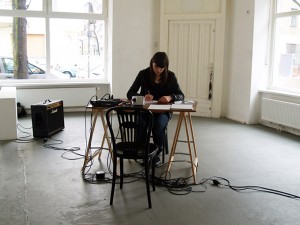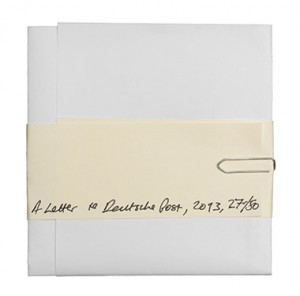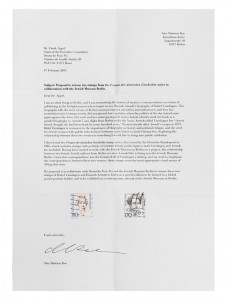An Interview with Alex Martinis Roe

Alex Martinis Roe, Encounters: Conversation in Practice, performance still, 2010.
Image courtesy of the artist.
To obtain a letter from a vending machine – even from an art vending machine – is rather unusual. In this interview, Australian artist Alex Martinis Roe explains what motivated her to create the artwork “A Letter to Deutsche Post.”
Christiane Bauer: Alex, you drafted a letter to Deutsche Post, asking the officers to reissue stamps depicting Rahel Varnhagen and Hannah Arendt. When our visitors purchase the letter, are they supposed to send it to Deutsche Post?
Alex Martinis Roe: I don’t expect visitors to send the letter to Deutsche Post, because I didn’t ask them to. They can do whatever they like with it. If they send it off, I’m happy. If they keep it, I’m also happy. (laughs) What I hope, is that they read the letter and become interested in the story.
Why did you choose to make a letter for the art vending machine?
I chose a letter because it fits inside the drawer of the art vending machine. I didn’t want to make a miniature, but instead work with something already that size. And I liked the idea of integrating this particular story about Hannah Arendt and Rahel Varnhagen into the Jewish Museum. I don’t have the resources to convince Deutsche Post to reissue the stamps, but I thought that the proposal itself is interesting.
Tell us about Arendt’s biography of Varnhagen, and why it should be a part of the Jewish Museum Berlin?
The story I would like to present at the Jewish Museum is one of two kindred spirits. Arendt wrote a biography of Varnhagen, a well-respected writer, who, like herself, was driven out of Berlin due to anti-Semitic persecution. Arendt draws a parallel implicitly, not explicitly, between her own life and the life of Varnhagen, conjuring up a relationship of a very important kind. In forming a link between herself and a female Jewish intellectual from another time, Arendt creates a matrilineal forebear, or genealogical link, to a Jewish woman, rather than – as is common among professional women seeking validation – to a man. She affirms her femininity and Jewishness, without defecting to the dominant culture of white, Christian men.
What topics are important for you in your work?
I’m interested in continental feminist philosophy as it interfaces with contemporary artists and art practices. They seek to build sexuate systems of meaning and validation – by that I mean cultures that are neither presumed to be universal, nor presumed to be made by or relevant to “anyone,” but rather are addressed to specific people. I don’t mean that these cultures are only for women, I mean that they take the difference of each person’s sexual embodiment into account. And right now, more specifically, I am interested in ways of creating connections and networks across time and space, and in troubling the nature-culture binary, which continues to be a source of violence against various differences, among them, sexual difference.
Since people may have diverging definitions of feminism, can you describe what the term “feminism” means for you?
I consider feminism the most peaceful revolution to occur and to continue occurring. Feminism changes the most fundamental way that societies are structured and the deepest, most intimate way people relate to one-another.
What are you currently working on?
Right now I’m making a map, or rather: a web of relations, between different feminist collectives involved, in one way or another, with publishing in Europe. My project is neither a survey nor a documentary, but a specific network of relationships between individual people. It is historic and contemporary at the same time. It spans a period from the early 1970s to the present. Making this map involves working with collectives, negotiating which stories should be told, and fostering a real relationship with the people I meet.
What is the link between your interest in feminist and feminine cultural production and your letter for the art vending machine?
The most important link between the aspects of feminism I mentioned and my letter for the art vending machine is the relationship between Hannah Arendt and Rahel Varnhagen as an example of my interest in genealogies of feminist practices. This term I coined implies being aware of the fact that my generation is indebted to previous generations of feminist activism. Previous activists remain alive in our actions. It’s a way to understand time and foster our relationships with older generations.
Many thanks for the interview, Alex!
Further information about the artist and her work can be found at her website: http://alexmartinisroe.com/

